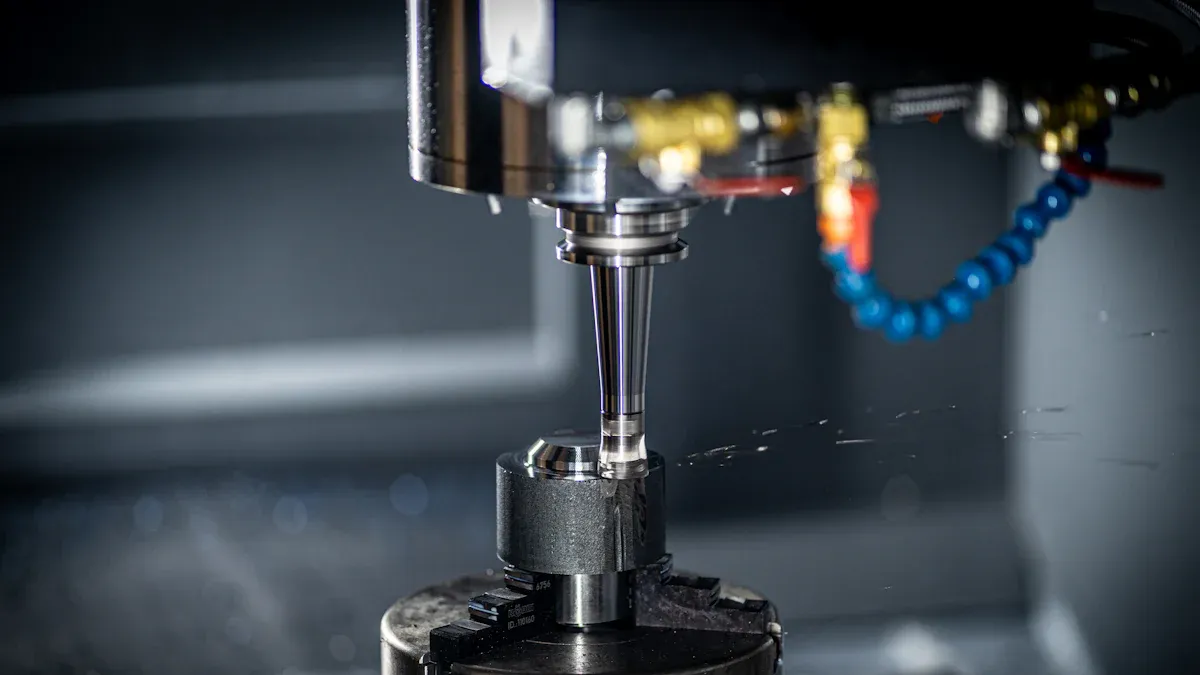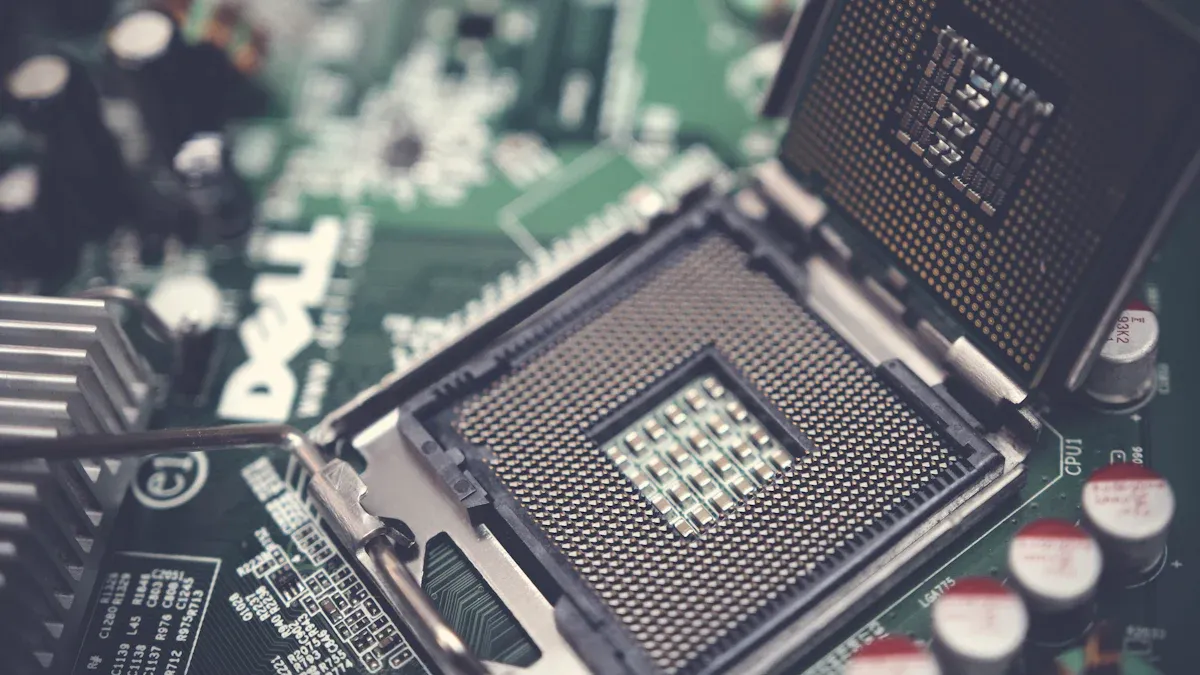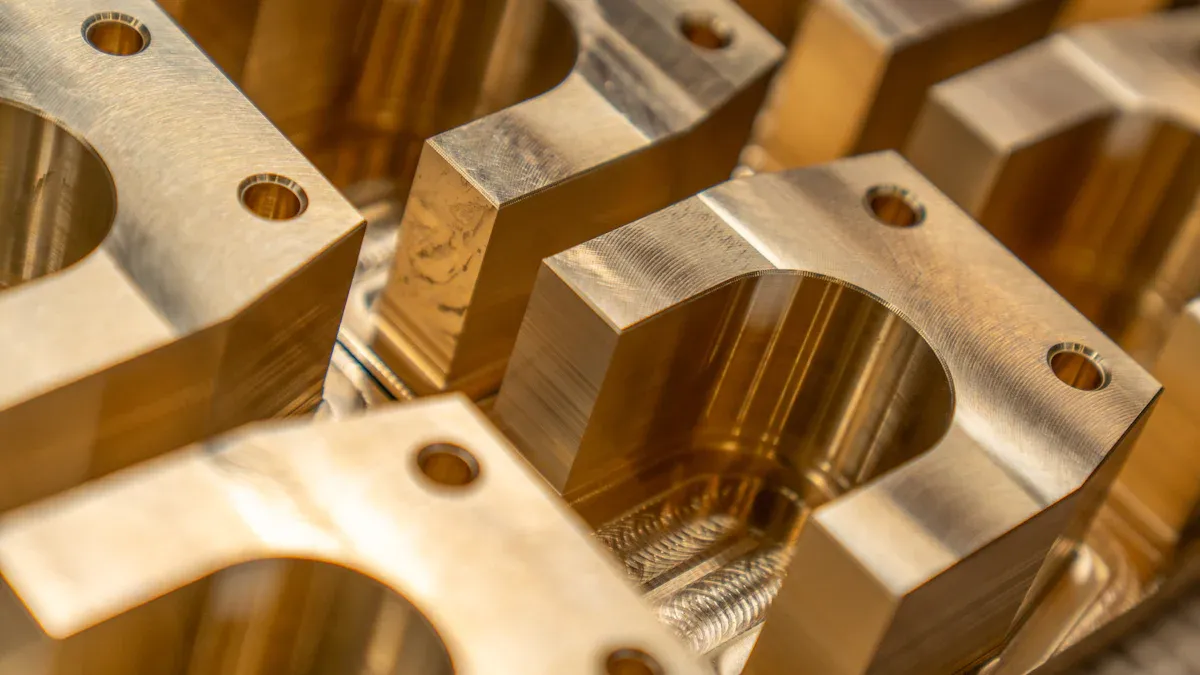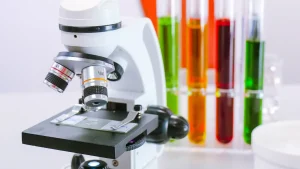
Graphite molds play a pivotal role in semiconductor manufacturing by ensuring precision and efficiency in production processes. Their unique properties, such as high thermal conductivity and resistance to extreme temperatures, make them indispensable.
- Global natural graphite production reached approximately 1.2 million metric tons in 2022, reflecting strong demand for graphite-based products.
- The graphite mold market is expected to grow at a compound annual growth rate (CAGR) of 5.4% from 2023 to 2030, driven by advancements in technology and increasing applications.
Innovations in graphite mold design address challenges like durability and scalability, enabling manufacturers to meet the growing demand for high-performance components. These advancements also extend to related products, such as graphite sheet&paper, graphite block, and graphite felt, which enhance the overall efficiency of semiconductor production. Additionally, components like the crankshaft pulley benefit from the precision and reliability offered by graphite molds.
Key Takeaways
- Graphite molds are important for making semiconductors. They handle heat well and work in very high temperatures. This helps make products accurately.
- New ideas in graphite mold design, like better materials and careful shaping, improve speed and save money. This makes precise manufacturing easier to do.
- Using recycled graphite and smart digital tools helps the environment. It also cuts costs for making products in the industry.
The Role of Graphite Molds in Semiconductor Manufacturing
Why Graphite Mold is Essential for Semiconductor Applications
Graphite molds serve as a cornerstone in semiconductor manufacturing due to their unique properties. Their ability to withstand high temperatures ensures reliability in processes requiring extreme heat. Additionally, their non-reactive nature prevents contamination when working with molten materials, enabling the production of intricate components with high precision.
The semiconductor industry is witnessing a surge in demand for high-precision molds, driven by advancements in 5G technology and IoT. This growth highlights the critical role of graphite molds in meeting industry requirements.
| Evidence Type | Description |
|---|---|
| Demand Surge | The semiconductor industry is experiencing a surge in demand for high-precision molds. |
| Temperature Resistance | Graphite molds can withstand high temperatures, making them suitable for semiconductor production. |
| Non-Reactivity | Their non-reactive nature with molten materials is crucial for producing intricate components. |
| Industry Growth Factors | The expansion of 5G technology and IoT is expected to further increase the demand for graphite molds. |
Applications of Graphite Mold in Precision Casting
Graphite molds play a vital role in precision casting processes, offering flexibility and efficiency. Manufacturers leverage these molds to produce components with superior surface finishes, reducing the need for extensive machining.
- The use of graphite molds in casting ZA-12 parts leads to significant cost savings and improved production efficiency.
- ZA-12 castings exhibit superior surface finishes and require less machining compared to traditional methods.
- Graphite molds allow for quick modifications, providing flexibility in product design and reducing financial risks associated with production changes.
Benefits of Graphite Mold in High-Temperature Environments
Graphite molds excel in high-temperature manufacturing environments due to their exceptional thermal stability and resistance to thermal shock. Industries such as aerospace and automotive rely on these molds to produce lightweight, high-strength materials with precise tolerances.
The aerospace sector uses hot bending graphite molds to achieve intricate shapes, while the automotive industry adopts them to enhance fuel efficiency and reduce emissions. The global market for hot bending graphite molds is projected to grow at a CAGR of 6.5% by 2030, reflecting their increasing importance in high-performance applications.
Challenges in Traditional Graphite Mold Design
Material Limitations in Durability and Performance
Traditional graphite molds face challenges in durability and performance due to the inherent properties of graphite. While graphite offers excellent thermal conductivity, its brittleness can lead to wear and tear during prolonged use. This limits its lifespan in high-stress manufacturing environments. Additionally, fluctuations in raw material prices, driven by geopolitical tensions and supply chain disruptions, have made it difficult for manufacturers to maintain consistent quality. Compounding these issues, alternative materials like ceramic and metal molds are gaining traction due to their superior thermal properties, further pressuring the graphite mold industry to innovate.
Precision and Consistency Issues in Traditional Mold Production
Achieving precision and consistency in traditional graphite mold production remains a significant hurdle. Variations in raw material quality and outdated machining techniques often result in molds with inconsistent dimensions. These inconsistencies can compromise the accuracy of semiconductor components, leading to higher rejection rates. Furthermore, the lack of advanced digital tools in traditional processes makes it challenging to meet the stringent tolerances required in modern semiconductor manufacturing. As industries demand higher precision, traditional methods struggle to keep pace with evolving standards.
Cost and Efficiency Challenges in Manufacturing Processes
Conventional graphite mold manufacturing processes often involve high costs and inefficiencies. While graphite molds reduce tooling expenses compared to metal molds, the initial production costs remain substantial. Additionally, traditional methods lack the flexibility to accommodate quick design changes, increasing financial risks for manufacturers. However, the scalability of graphite molds offers a cost advantage in medium-volume production runs, as it minimizes machining needs and reduces total costs per part. To remain competitive, manufacturers must address these inefficiencies and adopt more streamlined production techniques.
Key Innovations in Graphite Mold Design

Advanced Graphite Materials for Enhanced Performance
Recent advancements in material science have revolutionized graphite mold design. High-purity graphite and composite materials now dominate the industry due to their superior thermal conductivity and mechanical strength. These materials withstand higher temperatures without losing structural integrity, enabling faster production cycles. Studies show that advanced graphite materials improve production rates by up to 30%, making them indispensable for high-volume manufacturing. Additionally, lightweight graphite molds are tailored to produce energy-efficient components, particularly in the automotive sector. This innovation not only enhances performance but also aligns with sustainability goals by reducing energy consumption.
Precision Machining Techniques for High Accuracy
Modern machining techniques have significantly improved the accuracy of graphite molds. Technologies such as five-axis machining enable faster production while maintaining precise tolerances. Advanced inspection tools, including handheld scanners and CAD software, ensure quality control throughout the process. Additive manufacturing further complements traditional methods by allowing rapid prototyping and enhanced production capabilities. For instance, high-performance cutting tools designed specifically for moldmaking improve surface finishes, reducing the need for post-production machining. These advancements ensure that graphite molds meet the stringent requirements of semiconductor manufacturing.
| Technology/Technique | Contribution to Precision Machining |
|---|---|
| Five-axis machining | Enables faster machining while maintaining high accuracy, crucial for moldmaking. |
| Advanced inspection tools | Includes handheld scanners and CAD software, enhancing quality control in mold production. |
| Additive manufacturing | Integrates with traditional processes for rapid prototyping and improved production capabilities. |
| High-performance cutting tools | Designed for moldmaking, these tools improve cutting speeds and surface finishes, essential for quality. |
Integration of Digital Tools in Graphite Mold Design
Digital tools have transformed graphite mold design by enhancing efficiency and reducing errors. IoT and AI technologies enable predictive maintenance, where sensors monitor mold conditions in real time. This proactive approach minimizes downtime and extends mold lifespan. Digital twin technology allows manufacturers to test and optimize molds virtually before production, reducing waste and improving accuracy. Cloud-based monitoring systems provide real-time insights into mold performance, streamlining production schedules. These innovations ensure that graphite molds remain reliable and cost-effective in demanding manufacturing environments.
Surface Treatment Technologies for Improved Durability
Surface treatment technologies have addressed the durability challenges of graphite molds. Coatings such as silicon carbide and diamond-like carbon enhance wear resistance, extending the lifespan of molds in high-stress applications. These treatments also improve thermal stability, allowing molds to perform consistently under extreme conditions. By reducing surface roughness, treated molds achieve better release properties, which is critical for precision casting. This innovation not only improves the performance of graphite molds but also reduces maintenance costs, making them more economical for manufacturers.
Customization and Scalability in Graphite Mold Manufacturing
The shift toward customized graphite molds has enabled manufacturers to meet specific application requirements. Tailored molds enhance performance and reduce cycle times, particularly in industries like aerospace and automotive. Scalability has also improved, with digital tools allowing quick modifications to mold designs. For example, a lens processing equipment manufacturer transitioned from a four-part assembly to a single casting using graphite molds. This change resulted in significant cost and time savings, demonstrating the flexibility of modern mold production. These advancements ensure that graphite molds remain adaptable to evolving industry demands.
Impact of Innovations on Semiconductor Manufacturing

Enhanced Efficiency and Reduced Costs
Innovations in graphite mold design have streamlined semiconductor manufacturing processes. Advanced materials and precision machining techniques reduce production time by improving mold durability and accuracy. Manufacturers now achieve faster cycle times, which lowers operational costs. For instance, the integration of digital tools enables real-time monitoring, minimizing downtime and maintenance expenses. These advancements collectively enhance efficiency while reducing overall production costs, making high-precision manufacturing more accessible.
Improved Precision in Semiconductor Component Production
Modern graphite mold technologies ensure exceptional precision in semiconductor component production. Enhanced machining techniques and surface treatments allow manufacturers to achieve tighter tolerances. This level of accuracy reduces defects and improves product quality. Industries relying on intricate designs, such as aerospace and telecommunications, benefit significantly from these innovations. By delivering consistent results, graphite molds meet the stringent demands of cutting-edge semiconductor applications.
Scalability to Meet Industry Growth
The scalability of graphite mold manufacturing has improved significantly due to advancements in customization and digital design tools. Manufacturers can now quickly adapt molds to meet varying production volumes and specifications. This flexibility supports the rapid growth of industries like 5G and IoT, where demand for semiconductor components continues to rise. Scalable solutions ensure that manufacturers can keep pace with industry expansion without compromising quality or efficiency.
Environmental Advantages of Modern Graphite Mold Technologies
Modern graphite mold technologies contribute to sustainability in semiconductor manufacturing. High-purity materials and efficient production methods reduce waste and energy consumption. Additionally, surface treatments extend mold lifespan, decreasing the need for frequent replacements. These eco-friendly practices align with global efforts to minimize the environmental impact of industrial processes. By adopting these innovations, manufacturers not only enhance performance but also support a greener future.
Future Trends in Graphite Mold Design
Emerging Materials and Coatings for Next-Generation Graphite Molds
The development of advanced materials and coatings is shaping the future of graphite mold design. High-performance composites and innovative coatings, such as diamond-like carbon and silicon carbide, are enhancing mold durability and thermal stability. These materials withstand extreme conditions, making them ideal for high-precision applications. Additionally, biodegradable composites are gaining attention as eco-friendly alternatives. Research institutions are collaborating with manufacturers to create these sustainable materials, which promise to revolutionize the industry.
AI and Machine Learning in Graphite Mold Manufacturing
Artificial intelligence (AI) and machine learning are transforming graphite mold manufacturing. These technologies optimize production processes and improve mold quality.
- AI-driven automation and data analytics enhance operational efficiency.
- Real-time insights into mold performance enable predictive maintenance, reducing downtime.
- Digital twin technology allows virtual testing and optimization of mold designs, minimizing errors and waste.
By integrating these tools, manufacturers achieve higher precision and cost savings, ensuring molds meet the stringent demands of modern industries.
Sustainable Practices in Graphite Mold Production
Sustainability is becoming a cornerstone of graphite mold production. Manufacturers are adopting recycled graphite to conserve resources and reduce waste. This approach lowers production costs by up to 30%. Precision machining and additive manufacturing further enhance material efficiency, minimizing waste. Regulatory pressures and consumer demand for eco-friendly products are driving the adoption of cleaner technologies. Collaborative efforts among stakeholders are fostering the development of sustainable processes, signaling a strong shift toward environmentally conscious manufacturing.
Industry Collaboration for Advancing Graphite Mold Technologies
Partnerships are playing a pivotal role in advancing graphite mold technologies.
| Collaboration Type | Description | Impact |
|---|---|---|
| Manufacturers & Suppliers | Focus on developing sustainable materials | Enhances performance and sustainability |
| Research Institutions | Joint ventures for biodegradable composites | Revolutionizes the industry with eco-friendly alternatives |
| Technology Firms | Leverage synergies for innovation | Accelerates commercialization of new products |
These collaborations drive innovation, ensuring the graphite mold industry remains competitive and sustainable.
Graphite molds remain essential in semiconductor manufacturing, ensuring precision and efficiency. Key innovations, including precision machining and sustainable practices, have transformed the industry.
- Recycled graphite reduces costs and environmental impact.
- Advanced technologies enhance mold quality and material efficiency.
- Collaboration fosters sustainable material development.
Ningbo VET Energy Technology Co. leads advancements, driving innovation and sustainability in graphite mold design.
FAQ
What makes graphite molds suitable for semiconductor manufacturing?
Graphite molds offer high thermal conductivity, exceptional temperature resistance, and non-reactive properties. These characteristics ensure precision and reliability in semiconductor component production.
How do digital tools improve graphite mold design?
Digital tools enhance mold accuracy through virtual testing, predictive maintenance, and real-time monitoring. These innovations reduce errors, optimize performance, and streamline manufacturing processes.
Are modern graphite molds environmentally friendly?
Yes, modern graphite molds incorporate sustainable materials and efficient production methods. These practices reduce waste, conserve resources, and align with global environmental goals.






